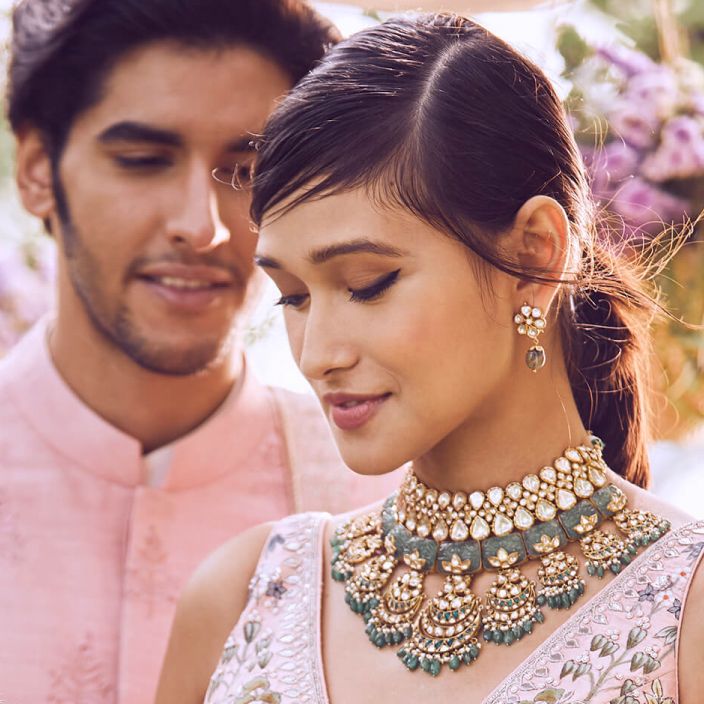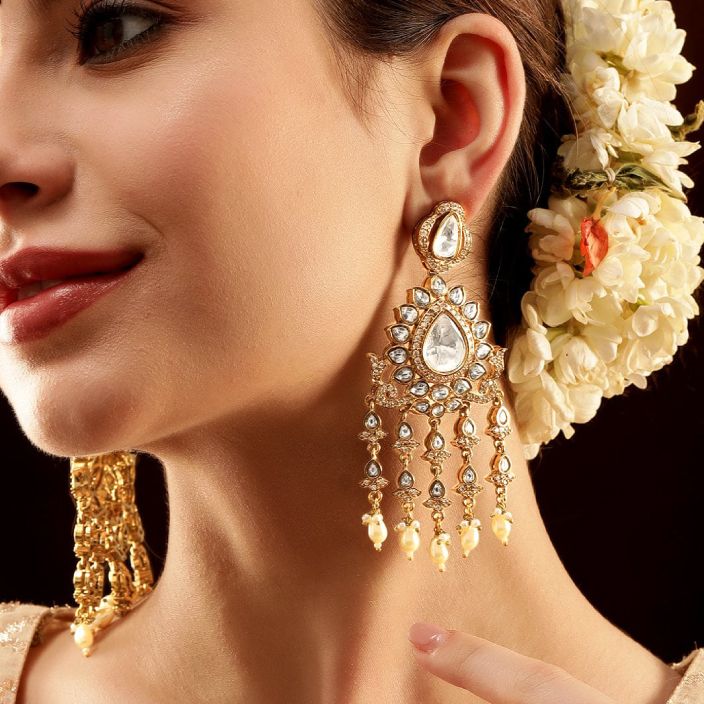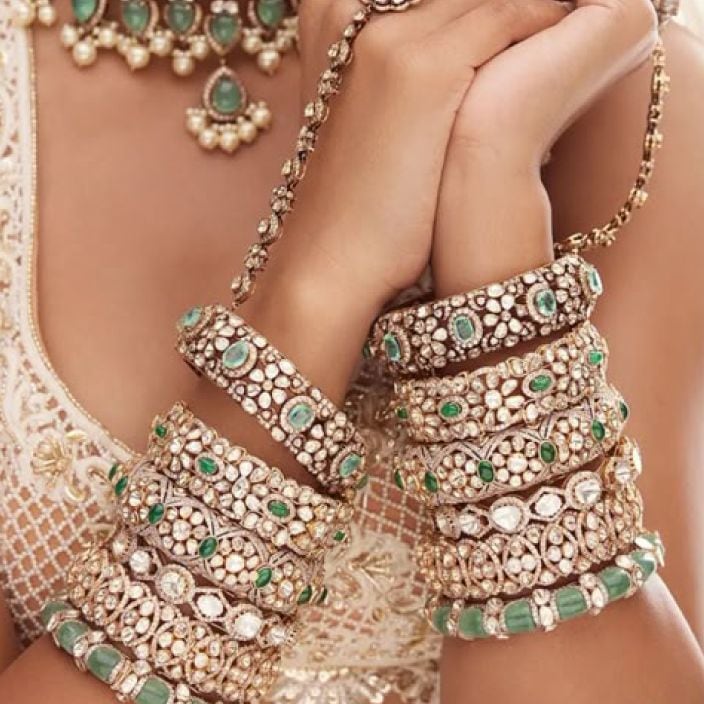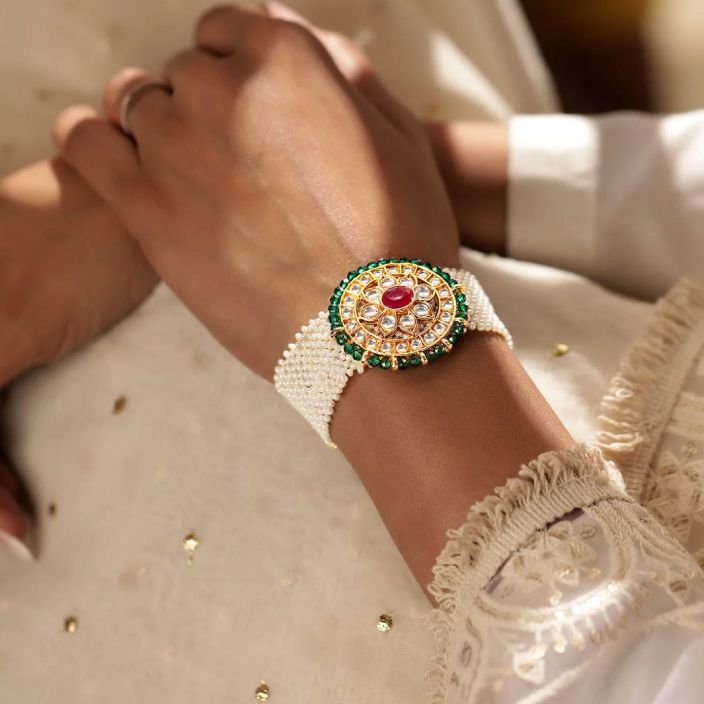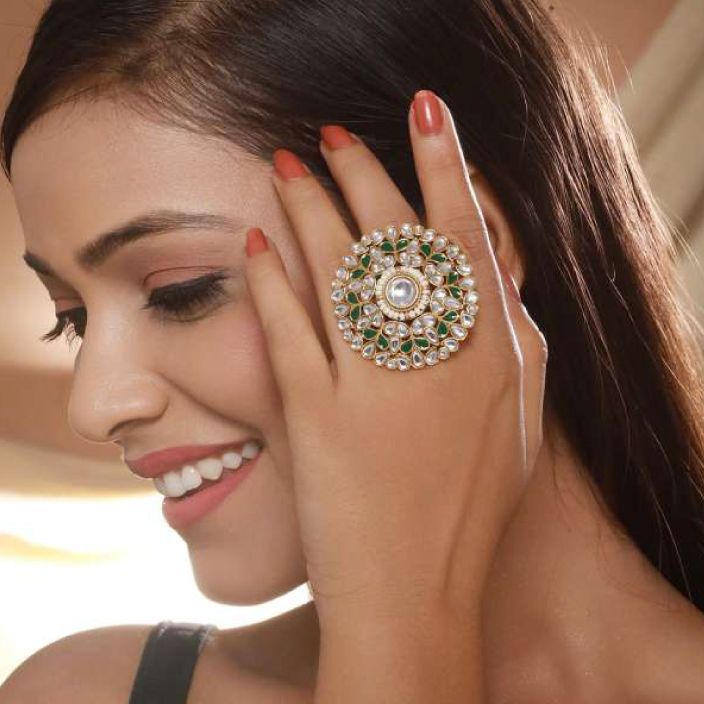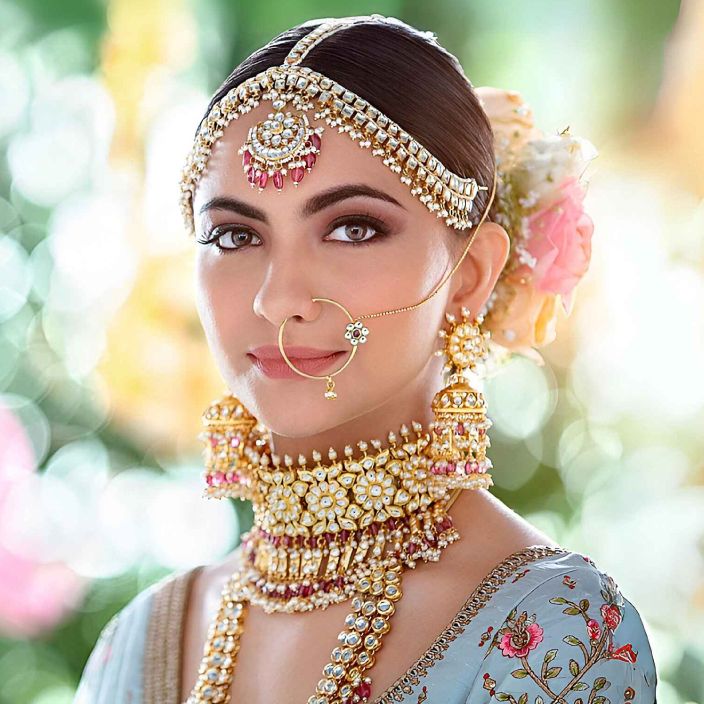For best prices and early deliveries, WhatsApp us at. 918488070070
Polki Jewellery
Polki jewellery gets its name from the diamonds used in it. The meaning of Polki jewellery lies in its historical and artisanal significance, as it represents one of the oldest forms of diamonds used in royal jewels. These natural diamonds, in their original raw and rough form, are only carved to follow the stone's original structure. They have an unfaceted polished surface that gives off much softer light compared to the sparkle of modern cuts. Uncut and unpolished diamonds used in their original state without any physical or chemical treatment are called Polkis. Polki jewellery has uncut diamonds as one of its core elements. It is crafted by placing the uncut Polkis using gold foils or strips and lac. The beauty of Polki jewellery lies in the imperfections of the Polkis. As no two Polkis are identical, each handcrafted jewellery piece looks distinctly unique and one-of-a-kind. There are three types of Polkis: Syndicate, Zimbabwe, and Kilwas. Syndicate Polkis have the best clarity, followed by Zimbabwean Polkis sourced from Zimbabwe in Africa. Kilwas Polkis are typical of low quality, colour, and clarity. Polki jewellery’s traditional and intricate designs lend timeless beauty and historical significance. Over the last few decades, several top Indian jewellery designers have created a renewed interest in Polki jewellery by launching their own line of Polki bridal wear. Celebrities have been wearing necklaces, earrings, bangles or bracelets with Polki diamonds and exquisite enamel work to red-carpet events and occasions. Today, Bikaner in Rajasthan remains the most revered hub for Polki jewellery. Jaipur and Hyderabad are also renowned for producing fine Polki pieces. Even Orissa, Uttar Pradesh, and Gujarat produce Polki jewellery. Though most factors remain the same, there may be some variation in design from one place to another depending on local preferences, innovations and techniques.
Tracing the Roots
The origin of Polki diamonds go back to the Mughal era. Sometime in the 17th century, royal goldsmiths in Rajput courts first introduced the art of Jadau Polki. Jadau , meaning to embed, is a technique used to set gemstones without any prongs. In this gemstone setting method, when rough diamonds with unfaceted and unpolished surfaces are embedded in a gold foil, it is called Polki jewellery.
Polki jewellery gained prominence as it spread from the Rajput royal courts in Bikaner and Jaipur to the Mughal court in Delhi. The gold, diamonds, intricate designs, and skilled craftsmanship symbolised wealth and aristocracy. Kings, Queens, and nobility began wearing Polki jewellery as a status symbol.
The Making of Polki Jewellery
Polki jewellery requires a high level of skill and expertise to craft. The traditional art, which originated in the Indo-Gangetic plains during the Mughal era, has been passed down through generations. While the crafting techniques are similar to Kundan jewellery, their construction is slightly different.
The artisans follow different types of polki settings while crafting Polki jewels. The first style of setting is called Badroom Polki. In this setting the Polkis are arranged in a tulle or jaali pattern with 24K gold. Another type of setting is the Takkar Polki setting, which entails lining up embedded Polkis closely, from edge to edge without using any metal packing. There is also the Jadau setting, where Polkis are placed in molten gold that solidifies around them. In the Kundan setting, gold foils encircle Polkis. Lastly, there is the Basra pearl setting. This setting uses real basra pearls along with the Polki diamonds.
There are also Closed Polki and Open Polki. Closed Polki is the traditional way of setting, in which the gemstones are set quite close with little metal visible between them. On the other hand, the Open Polki Jewellery has more visible spaces between the stones, allowing more light to enter and reflect on the surface of the Polki diamonds. It also uses modern techniques, takes less time to craft, and is more affordable.
In all these settings, the method or process remains the same. First, the design is conceptualised and finalised. Next, the Chiterias or mould specialists make the framework in 22-karat gold. Once the mould is ready, the Ghaarias engrave the mould with traditional motifs. Next, the Meenakar applies colourful enamel to the piece. Finally, the jewellery mould goes to the Jadia or setter, who sets the uncut Polkis using 24-karat gold. The entire process is time-consuming, and it can take months to craft a single Polki necklace, bangle or earrings.
Polki was the name applied to India’s traditional uncut diamonds, where the cutter stayed close to the natural form of the stone. Today, with innovations, Polkis are faceted lightly to resemble modern-cut diamonds, such as round brilliants, cushions, and princess cuts. These laser-cut Polkis are more proportionate, polished, and brilliant. They are even set alongside other precious stones like rubies, sapphires, and emeralds.
Cultural Significance
Polki is the answer for buyers looking for jewellery with deep roots in India’s history and culture. Royalty and nobility in the Mughal era wore aristocratic Polki bangles, earrings, rings and necklaces, symbolising wealth and status.
As the enamelled motifs carry a meaning, Polki jewellery is termed auspicious and hence worn at weddings and festivals. Polki jewellery is also the perfect heirloom piece. From Aad necklaces to jhumkas, Bridal Polki jewellery is a perennial favourite of new-age brides.
Evolution & Adaption
From royal heirlooms to contemporary glam, the versatile Polki jewellery has gained a prominent place, especially in Indian bridal adornment. While natural, uncut and inclusion-free Polkis are still the first choice of jewellery designers, treated Polkis are also available now.
During India’s colonial period, the Mughal Polki jewellery incorporated European designs, motifs and techniques. Further, imitation versions of the original Polki earrings, bangles, necklaces etc., are available at lower costs.
These typically use glass, cubic zirconia, synthetic gemstones and alloy metal.
Polki jewellery has undergone mechanical and technical improvisations. Even after 2500 years since its beginning, Polki masterpieces continue to impress the gemmaphiles!
